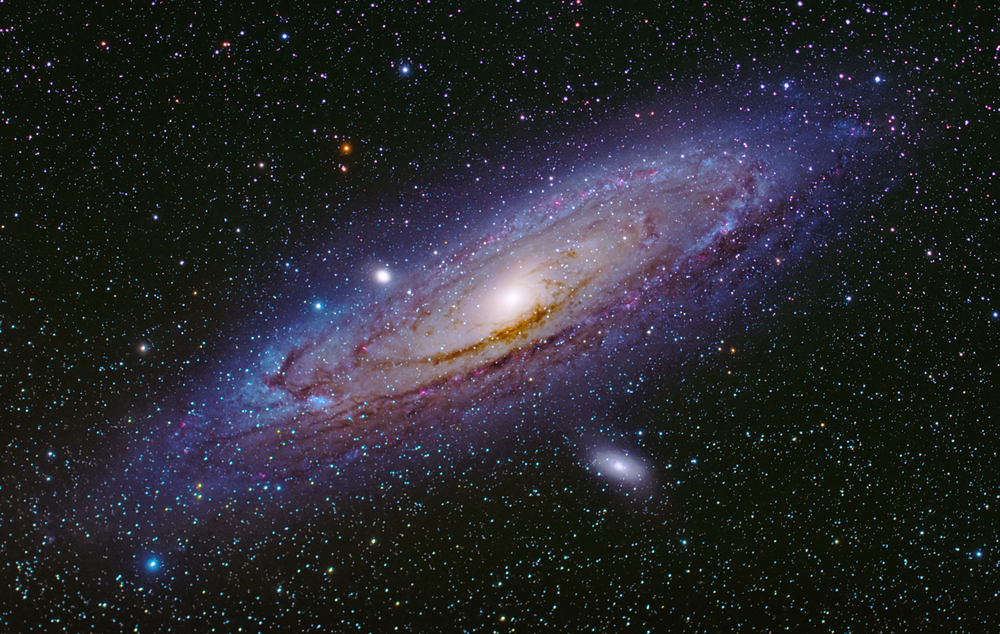10 Facts You May Not Know About the Milky Way
Posted on Categories Discover Magazine

The Milk Way is the galaxy our solar system calls home. For thousands of years, the Milky Way’s beauty and wonder have inspired legendary stories and curious astronomers gazing at the night sky.
We’ve only recently learned some of the fascinating details of the Milk Way. While there is still more left to be uncovered, here are 10 facts we know about the Milk Way.
(Credit: NASA/JPL-Caltech)
1. How Big Is the Milky Way?
According to NASA, the Milky Way galaxy is about 100,000 light-years across. Wide may be an understatement.
However, our neighboring galaxy, Andromeda, is roughly 220,000 light-years across. And some can be millions of light-years wide.
Read More: How Big Is the Milky Way?
2. How Does Our Solar System Move Around the Milky Way?
Much like our planet moves around the sun, our solar system also orbits around the center of the Milky Way. Instead of taking one year, however, our solar system takes about 230 million years to complete one turn around the galactic center.
That means the last time the solar system was where we are now, the Jurassic Period was in its infancy.
3. What Is at the Center of the Milky Way?
(Credit:NASA)
Our solar system and all other matter within the Milky Way revolve around a supermassive black hole, commonly called Sagittarius A* (pronounced “Sagittarius A star”). This supermassive black hole is dormant and only occasionally absorbs dust and gases.
According to NASA, Sgr A* has a mass about 4 million times that of our sun. Because of its proximity to Earth (26,000 light-years), researchers can witness and observe how matter interacts with the black hole.
4. How Did the Milky Way Get Its Name?
The Milky Way may get its name from an Ancient Greek legend. According to the myth, when Hera was nursing Heracles (Hercules), the infant spilled some of the milk and streaked it across the sky. Because of its milky-white appearance, the name stuck. However, a similar name is used in many other languages.
And our galaxy goes by several other names around the globe: According to the American Museum of Natural History, in the Kalahari Desert in South Africa, the galaxy is referred to as the “backbone of night” and “silver river” in China.
5. What Shape Is the Milky Way?
(Credit: Hubble Heritage Team (STScI / AURA), C. Conselice (U. Wisconsin / STScI) et al., NASA)
According to the European Space Agency (ESA) — whose 2013 Gaia mission helped map the Milky Way — the Milky Way disk isn’t flat, but warped. It wobbles as it moves through the universe, like a spinning top.
Though not known for sure, some researchers believe that a collision with another galaxy caused the wobble.
Read More: Astronomers Rethink the Milky Way’s Shape
6. How Was Milky Way Formed?
Thanks to the ESA Gaia mission, researchers can better understand how the Milky Way galaxy may have formed. For instance: In 2018, using Gaia data, researchers from the University of Groningen in the Netherlands noticed a cluster of 30,000 stars moving in a direction opposite that of most of the galaxy’s other stars.
Further analysis with the Hertzsprung-Russell diagram — a diagram that plots and classifies the brightness and temperature of stars to help us understand stellar evolution and life cycles — concluded that this cluster of stars was from a different galaxy, the result of a past galactic merger.
7. When Will the Milky Way and Andromeda Galaxies Collide?
While a possible galactic collision may have already knocked the Milky Way off-kilter, there is another collision on the horizon — 4 billion years from now, anyway. Thanks to the Hubble Space Telescope, researchers have determined that in approximately 4 billion years, the Andromeda Galaxy — our closest cosmic neighbor — will collide with the Milky Way.
According to NASA’s predictions, our sun would move to a different area of the galaxy, but the solar system would not be destroyed. Simulations also show that after the two galaxies collide, they will eventually be pulled together into one — which some have nicknamed “Milkomeda.”
8. What Is the Milky Way Made Of?
If you gaze up at the sky on a clear night, and you’re far enough away from light pollution, you can see the brightness of the Milky Way. What we can see of the galaxy is bright and illuminated by billions of stars. However, according to NASA, what we can see of the Milky Way only makes up about 5 percent of the galaxy’s mass.
The rest of the mass of galaxy, researchers believe, is made up of a mysterious substance called dark matter — which doesn’t emit light and can’t be directly measured.
Read More: Most Distant Dark Matter Ever Found Dates Back 12 Billion Years
9. How Many Planets Are in the Milky Way?
With billions and billions of planets in the Milky Way, there may be life outside of our solar system.
Thanks to the information and data from the Kepler Space Telescope, researchers have identified several exoplanets (planets outside our solar system) within the habitable zone of their own stars.
10. How Many Stars Are in the Milky Way?
(Credit: NASA, ESA, and G. Brammer)
Most estimates suggest least 100 billion stars in our galaxy, perhaps up to 400 billion. And an untold and unimaginable number is also spread throughout the rest of the universe. The stars we can see from Earth only make up a tiny fraction of what the Milky Way contains.
Read More: What Happens When a Star Dies?